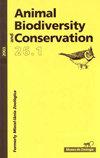在沙滩上兴建行人道以改善环境?鬼蟹(甲壳纲,潜蟹科)个案研究
IF 1
4区 环境科学与生态学
Q3 BIODIVERSITY CONSERVATION
引用次数: 0
摘要
由于受到各种自然因素的影响,许多物种只能在少数有利的栖息地中生存,因此从人类干扰的海滩上消失了。然而,作为对干扰的响应,流动物种可能会改变其分布并选择更合适的栖息地。鬼蟹是为数不多的能够移动相当距离的海滩居民动物之一,但通常的城市海滩栖息地的同质性理论上阻止了它们寻找避难所。在这里,我在巴西东南部的四个海滩上测试了通道是否为鬼蟹提供了栖息地。在2020年6月至2021年5月期间,我计算并测量了人行道下和周围横断面上距离这些结构不同距离的洞穴开口直径。人行道外横断面的平均洞穴密度是人行道下横断面的3倍。然而,洞穴更大,位置离人行道下的水线更远。因此,在市区泳滩设置行人道可保护鬼蟹不受行人踩踏和车辆来往的影响,因此可作为管理和保护沙滩生物多样性的环境丰富工具。本文章由计算机程序翻译,如有差异,请以英文原文为准。
Walkways as an environmental enrichment tool on sandy beaches? A case study with ghost crabs (Crustacea, Ocypodidae)
Confined to a few favorable patches of habitat within a mosaic of physical drivers, many species disappear from human-disturbed beaches. However, mobile species may change their distribution and select more appropriate habitats as a response to disturbance. Ghost crabs are one of the few beach resident animals capable of moving over considerable distances, but usual habitat homogeneity of urban beaches theoretically prevents them from finding refuge. Here, I tested whether access walkways provide a habitat for ghost crabs on four beaches in southeastern Brazil. I counted and measured burrow opening diameter under walkways and in surrounding transects located at various distances from these structures between June 2020 and May 2021. Mean burrow density was three times higher in transects out of walkways than under the walkways. However, burrows were larger and positioned farther from the waterline under walkways. Walkways thus possibly provide protection for ghost crabs from trampling and vehicle traffic in urban beaches and could therefore be applied as an environmental enrichment tool in the management and conservation of sandy beach biodiversity.
求助全文
通过发布文献求助,成功后即可免费获取论文全文。
去求助
来源期刊

Animal Biodiversity and Conservation
农林科学-动物学
CiteScore
2.00
自引率
0.00%
发文量
21
审稿时长
>12 weeks
期刊介绍:
Animal Biodiversity and Conservation (antes Miscel·lània Zoològica) es una revista interdisciplinar, publicada desde 1958 por el Museu de Ciències Naturals de Barcelona. Incluye artículos de investigación empírica y teórica en todas las áreas de la zoología (sistemática, taxonomía, morfología, biogeografía, ecología, etología, fisiología y genética) procedentes de todas las regiones del mundo. La revista presta especial interés a los estudios que planteen un problema nuevo o introduzcan un tema nuevo, con hipòtesis y prediccions claras, y a los trabajos que de una manera u otra tengan relevancia en la biología de la conservación. No se publicaran artículos puramente descriptivos, o artículos faunísticos o corológicos en los que se describa la distribución en el espacio o en el tiempo de los organismes zoológicos.
 求助内容:
求助内容: 应助结果提醒方式:
应助结果提醒方式:


